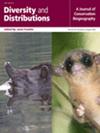Historical Demographic Determinants Complement Climate Model Predictions of Co-Occurring Cryptic Species
Abstract
Aim
We explore the impact of demography and biogeographic history on the interpretation of ecological niche model, highlighting the potential for integrating genetic and ecological approaches to elucidate the evolutionary dynamics underlying the geographic distributions of cryptic species.
Location
Western Palaearctic (Africa and Europe).
Methods
We conducted intensive sampling across the Iberian Peninsula to obtain mtDNA phylogeographic data and to develop fine-scale ecological niche models, projecting these models into both past and future scenarios for the cryptic earwigs Forficula dentata and F. mediterranea. Additionally, we utilised Bayesian skyline plot (BSP) analyses to reconstruct demographic histories and infer past population trends for both species.
Results
The phylogeographic patterns revealed divergent evolutionary histories: F. dentata exhibited a well-established, geographically structured lineage, whereas F. mediterranea displayed a star-shaped pattern characteristic of recent expansion. Comparison between current climate models and those projected into the past and future indicate that F. dentata is likely facing a substantial reduction in its suitable habitat due to ongoing climate change, possibly exacerbated by increasing competition with F. mediterranea.
Main Conclusions
Our results suggest that climatic factors alone cannot determine the distribution of cryptic species. Historical and demographic factors play a crucial role in shaping their current geographical structure. In addition, human-mediated dispersal and ongoing climate change may contribute to the genetic and spatial structure within the F. auricularia species complex. Overall, exploring the intricate interplay between historic, genetic and geographic distribution is recommended to overcome contradictory predictions of climate models.


 求助内容:
求助内容: 应助结果提醒方式:
应助结果提醒方式:


